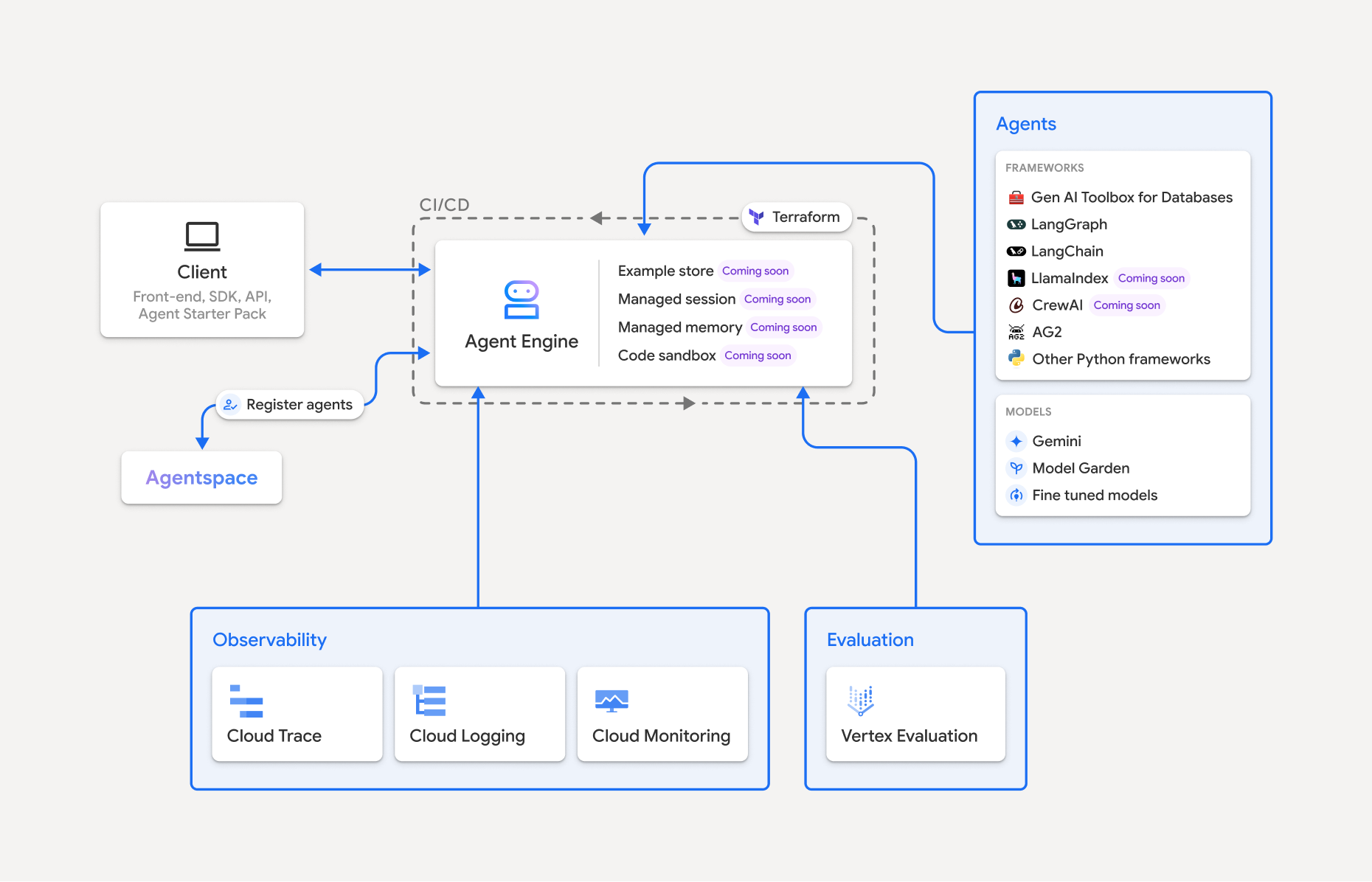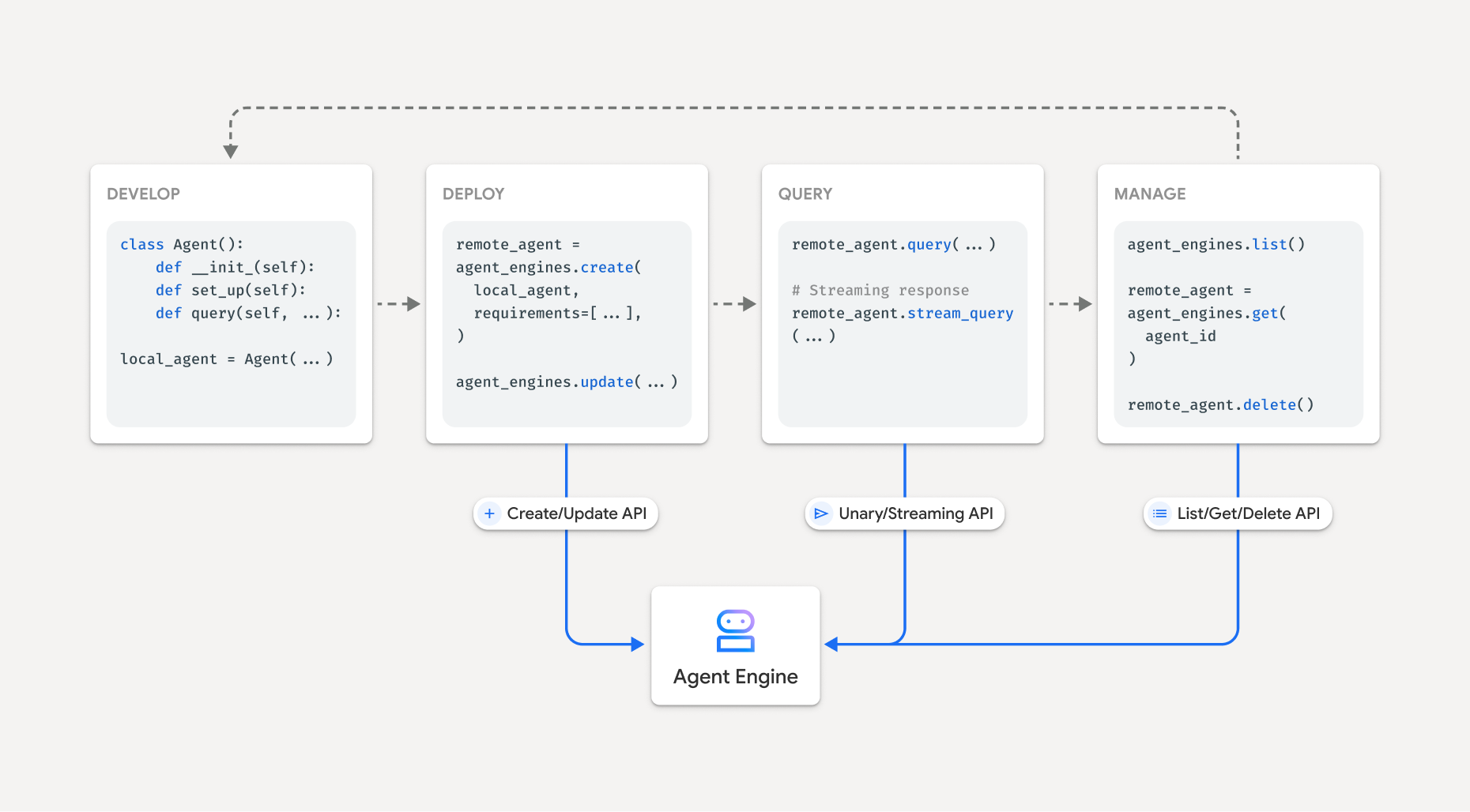Vertex AI Agent Engine(이전 명칭: Vertex AI 기반 LangChain 또는 Vertex AI Reasoning Engine)은 개발자가 프로덕션에서 AI 에이전트를 배포, 관리, 확장할 수 있는 완전 관리형 Google Cloud 서비스입니다. Agent Engine은 인프라를 처리하여 프로덕션에서 상담사를 확장하므로 개발자는 지능적이고 강력한 애플리케이션을 만드는 데 집중할 수 있습니다. Vertex AI Agent Engine은 다음을 제공합니다.
완전 관리형: VPC-SC 규정 준수 및 포괄적인 엔드 투 엔드 관리 기능을 포함한 강력한 보안 기능을 제공하는 관리형 런타임으로 에이전트를 배포하고 확장합니다. 성능 모니터링 및 트레이스에 Google Cloud Trace(OpenTelemetry 지원)를 사용하는 멀티 에이전트 애플리케이션에 대한 CRUD 액세스 권한을 얻습니다. 자세한 내용은 에이전트 배포를 참조하세요.
품질 및 평가: 통합된 Gen AI Evaluation Service를 사용하여 에이전트 품질을 보장합니다.
간소화된 개발: Vertex AI Agent Engine은 애플리케이션 서버 개발, 인증 및 IAM 구성과 같은 하위 수준 태스크를 추상화하므로 동작, 도구, 모델 파라미터와 같은 에이전트의 고유한 기능에 집중할 수 있습니다. 또한 에이전트는 Vertex AI에서 함수 호출과 같은 모든 모델과 도구를 사용할 수 있습니다.
프레임워크 독립형: LangGraph, Langchain, AG2, CrewAI를 포함한 다양한 Python 프레임워크를 사용하여 빌드한 에이전트를 유연하게 배포할 수 있습니다. 기존 에이전트가 이미 있는 경우 SDK의 커스텀 템플릿을 사용하여 Vertex AI Agent Engine에서 실행되도록 조정할 수 있습니다. 또는 Google에서 제공하는 프레임워크별 템플릿 중 하나를 사용하여 에이전트를 처음부터 개발할 수 있습니다.

Vertex AI Agent Engine에서 만들기 및 배포
참고: Vertex AI Agent Engine으로 간소화된 IDE 기반 개발 및 배포 환경을 사용하려면 agent-starter-pack을 고려하세요. 즉시 사용할 수 있는 템플릿, 실험을 위한 기본 제공 UI를 제공하고 배포, 운영, 평가, 맞춤설정, 관찰 가능성을 간소화합니다.
Vertex AI Agent Engine에서 에이전트를 빌드하는 워크플로는 다음과 같습니다.
| 단계 | 설명 |
|---|---|
| 1. 환경 설정 | Google 프로젝트를 설정하고 Vertex AI SDK for Python의 최신 버전을 설치합니다. |
| 2. 에이전트 개발 | Vertex AI Agent Engine에서 배포할 수 있는 에이전트를 개발합니다. |
| 3. 에이전트 배포 | Vertex AI Agent Engine 관리형 런타임에서 에이전트를 배포합니다. |
| 4. 에이전트 사용 | API 요청을 전송하여 에이전트를 쿼리합니다. |
| 5. 배포된 에이전트 관리 | Vertex AI Agent Engine에 배포한 에이전트를 관리하고 삭제합니다. |
단계는 다음 다이어그램에 나와 있습니다.

사용 사례
엔드 투 엔드 예시를 통해 Vertex AI Agent Engine을 알아보려면 다음 리소스를 참조하세요.
엔터프라이즈 보안
Vertex AI Agent Engine은 데이터 보안이 강화되고 데이터 무단 반출 위험이 완화되도록 VPC 서비스 제어를 지원합니다. VPC 서비스 제어가 구성되면 배포된 에이전트는 BigQuery API, Cloud SQL Admin API, Vertex AI API와 같은 Google API 및 서비스에 대한 보안 액세스 권한을 유지하므로 정의된 경계 내에서 원활한 작업을 보장합니다. 중요한 점은 VPC 서비스 제어는 모든 공개 인터넷 액세스를 효과적으로 차단하여 승인된 네트워크 경계로 데이터 이동을 제한하고 엔터프라이즈 보안 상황을 크게 향상시킨다는 점입니다.
지원되는 리전
Vertex AI Agent Engine은 다음 리전에서 지원됩니다.
| 지역 | 위치 | 설명 | 출시 단계 |
|---|---|---|---|
us-central1 |
아이오와 | v1 및 v1beta1 버전이 지원됩니다. |
GA |
us-west1 |
오리건 | v1 및 v1beta1 버전이 지원됩니다. |
GA |
europe-west1 |
벨기에 | v1 및 v1beta1 버전이 지원됩니다. |
GA |
europe-southwest1 |
마드리드 | v1 및 v1beta1 버전이 지원됩니다. |
GA |
asia-east1 |
대만 | v1 및 v1beta1 버전이 지원됩니다. |
GA |
asia-northeast1 |
도쿄 | v1 및 v1beta1 버전이 지원됩니다. |
GA |
할당량
다음 할당량 및 한도는 각 리전의 특정 프로젝트에 대한 Vertex AI Agent Engine에 적용됩니다.| 할당량 | 값 |
|---|---|
| 분당 Vertex AI Agent Engine 만들기/삭제/업데이트 수 | 10 |
| 분당 Vertex AI Agent Engine 쿼리/스트림 쿼리 | 60 |
| 최대 Vertex AI Agent Engine 리소스 수 | 100 |
가격 책정
가격은 Vertex AI Agent Engine 관리형 런타임에 배포된 에이전트에서 사용하는 컴퓨팅(vCPU 시간) 및 메모리(GiB 시간) 리소스를 기준으로 책정됩니다.
| Product | SKU ID | 가격 |
|---|---|---|
| ReasoningEngine vCPU | 8A55-0B95-B7DC | 시간당 $0.0994/vCPU |
| ReasoningEngine 메모리 | 0B45-6103-6EC1 | 시간당 $0.0105/GiB |
자세한 내용은 가격 책정을 참조하세요.
